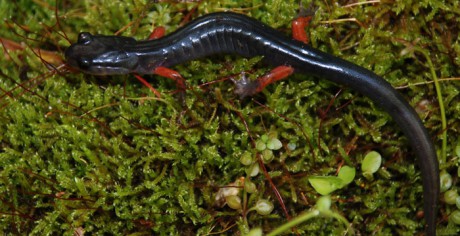Scientists prove ground and tree salamanders have same diets

Salamanders spend the vast majority of their lives below ground and surface only for short periods of time and usually only on wet nights. When they do emerge, salamanders can be spotted not only on forest floors but also up in trees and on other vegetation, oftentimes climbing as high as 8 feet up. Given their infrequent appearances aboveground, it has never been clear to biologists why salamanders take time to climb vegetation. Researchers at the University of Missouri recently conducted a study testing a long-standing hypothesis that salamanders might climb vegetation for food.
“Previous research suggested that plant climbing might be a way for salamanders to access additional prey items, like aphids and leaf hoppers, that are not available on the ground,” said Grant Connette, a biologist who helped carry out the study while a graduate student in the Division of Biological Sciences at MU.
Connette and his colleagues tested the hypothesis by collecting red-legged salamanders (Plethodon sharmani) and examining their stomach contents. The researchers captured an equal number of salamanders on the ground and up on trees or shrubs and then brought them back to the lab, where they anesthetized them and flushed the stomachs of their contents. The salamanders – minus their last meals – were then safely returned to their exact capture location.
The stomach contents were preserved in alcohol and then subsequently dissected apart. Students, assisted by MU Curators’ Professor James Carrel and Research Entomologist Mark Deyrup with the Archbold Biological Station in Florida, identified each prey item to the lowest taxonomic level and calculated its mass. At the end, they had a laundry list of things found in the guts of these salamanders.
“The dominant groups were mites, millipedes, beetles, and an assortment of ants,” said Carrel. “What was surprising was that the [salamanders] collected on trees did not have anything one would associate with a plant-feeding insect, like aphids.”
The diet of the salamanders captured on the ground was the same as the diet of salamanders captured sitting high up on vegetation.
“We found no evidence that climbing allows these salamanders to more fully exploit available food resources, which instead suggests that other mechanisms, such as competition or predator avoidance, might be important influences on salamander populations,” said Connette.
The study was prompted by the research of Curators’ Professor Ray Semlitsch, who has been studying salamander populations in the Appalachian Mountains since 2005. The mountain range’s moist forests make it a global hot spot for a variety of salamander species.
Connette said that by testing a possible explanation for climbing behavior, the research also provides important background information about how salamanders can exist in high densities in North American forests.
The study, “Relationship between diet and microhabitat use of red-legged salamanders (Plethodon shermani) in southwestern North Carolina,” appeared in the journal Copeia.
Written by: Melody Kroll
Media Contact
All latest news from the category: Life Sciences and Chemistry
Articles and reports from the Life Sciences and chemistry area deal with applied and basic research into modern biology, chemistry and human medicine.
Valuable information can be found on a range of life sciences fields including bacteriology, biochemistry, bionics, bioinformatics, biophysics, biotechnology, genetics, geobotany, human biology, marine biology, microbiology, molecular biology, cellular biology, zoology, bioinorganic chemistry, microchemistry and environmental chemistry.
Newest articles

Trotting robots reveal emergence of animal gait transitions
A four-legged robot trained with machine learning by EPFL researchers has learned to avoid falls by spontaneously switching between walking, trotting, and pronking – a milestone for roboticists as well…

Innovation promises to prevent power pole-top fires
Engineers in Australia have found a new way to make power-pole insulators resistant to fire and electrical sparking, promising to prevent dangerous pole-top fires and reduce blackouts. Pole-top fires pose…

Possible alternative to antibiotics produced by bacteria
Antibacterial substance from staphylococci discovered with new mechanism of action against natural competitors. Many bacteria produce substances to gain an advantage over competitors in their highly competitive natural environment. Researchers…





















